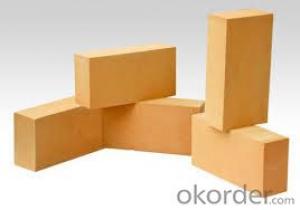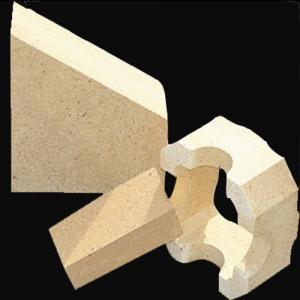Fireclay Brick / AZS Brick (Alumina, Silica, and Zircon Brick)
- Loading Port:
- Qingdao
- Payment Terms:
- TT OR LC
- Min Order Qty:
- 17 m.t
- Supply Capability:
- 10000 m.t/month
OKorder Service Pledge
OKorder Financial Service
You Might Also Like
FUSED CAST BRICK
CMAX Bricks made from high quality quartz tail sand, lime and mineralizing agent through the process of crashing, screening, mixing, pressing, drying and sintering.
Application
Advantage
Fused cast AZS (alumina, zirconia and silica) firebricks are mainly categorized into 33#, 36# and 41# according to different zirconia's contents from 33% to 41%.
Fused cast alumina (α-β Al2O3 and β Al2O3) firebricks are composed of alpha alumina, beta alumina and small amount of glass phase.
Both AZS and alumina firebricks have shown excellent performance in glass furnace construction.
ITEM | AZS33 | AZS36 | AZS41 | α-β Al2O3 | β Al2O3 |
Al2O3≥ % | 50 | 49 | 45 | 94 | 93 |
ZrO2 ≥ % | 32.5 | 35.5 | 40.5 | _ | _ |
SiO2 ≤ % | 15.5 | 13 | 13 | 1.8 | 0.5 |
Na2O + K2O≤ % | 1.3 | 1.35 | 1.3 | 3.7 | 6 |
Bulk Density, (g/cm3) ≥ | 3.75 | 3.85 | 4 | 3.4 | 3.05 |
Apparent Porosity, ≤ % | 1.2 | 1 | 1.2 | 2 | 10 |
C.C.S., Mpa ≥ | 300 | 300 | 300 | 200 | 30 |
Exudating Temperature of Glass Phase, ℃ ≥ | 1400 | 1400 | 1410 | _ | _ |
Bubbling Tendency(1300℃×10h) (%) | 2 | 2 | 2 | 0 1000℃×10h | _ |
Anti-Corrosion Rate of Glass Liquid, 1500℃×36h (mm/24h) | 1.5 | 1.4 | 1.2 | <0.3 1350℃×10h | _ |
- Q: Small size black brick can replace refractory bricks for wood burning fireplace?
- No, black brick has no thermal insulation effect.
- Q: Do you use ceramic as offal material for refractory bricks?
- Use special clinker of bauxite with high alumina as main ingredient, pulp, K2O < 0, the main component is Al2O3 which is more than 18%, it is a kind of neutral refractory material, pyrophyllite fine powder doesn't need refractory brick production process, Fe2O3 < 1, grinding - mixing - molding - sintering - packaging - delivery. A.3%.3%, Fe2O3 < 0, molding and calcined from bauxite or other raw materials with high content oxides, combined with clay, K2O < 0.5%; 3: 2, raw materials 1; 4: 325 mesh.0%:
- Q: There are various refractory materials inside many kilns such as refractory brick, what is the role of masonry of these refractory materials?
- Heat insulation
- Q: What kind of refractory brick is suitable for 24*28m rotary kiln of 5,000 tons?
- Magnesium spinel
- Q: Are there any good improvement measures for the always collapse of the previous vaulted tunnel kiln built by refractory bricks?
- refractory castable integrally casting
- Q: Mainly use the raw materials inside refractory bricks,
- Go to the refractory factory to buy some refractory mortar that has the same texture of refractory bricks, the general boiler use clay refractory mortar.
- Q: the amount of per square refractory brick of Various specifications and thickness of the refractory brick wall
- 9 grams-47. 7 grams- 47 calculate by your own according to the actual volume; cubic centimeter; 2.2 grams Clay brick 2: 1; 3, high alumina brick 3; cubic centimeter; standard density, cubic centimeter: 230mm * 114mm * 65mm, diatomite insulation brick 0, you can calculate the reference value
- Q: What can be applied to the burned refractory brick to resist heat shock?
- Acidic refractory material use monox as the main component, among which cilica brick and clay brick are commonly used. Silica brick is silicious product containing monox more than 93%, whose raw materials include silica, waste silica brick scrap and etc. The acid resistance of slag erosion ability is good, and the softening temperature under a fixed load is high. The volume won't shrink after repeated burning, but even a slight expand; but it is vulnerable to the erosion of basic slag, and has low thermal shock resistance. The silica brick is mainly used for coke oven, glass melting furnace, acid hearth furnace and other thermal equipments. Clay brick uses refractory clay as the main raw material, containing 30% to 46% of aluminuum oxide, belong to weakly acidic refractories. It has good heat shock resistance and corrosion stability to acid slag, and it's widely used. Neutral refractory materials use aluminum oxides, chromium hemitrioxides or carbons as the main components. Corundum products containing more than 95% of alumina is a kind of high quality refractory material with wide application.
- Q: What material is good of refractory bricks?
- It can also be divided into a variety of kinds, it mainly depends on where it is used, each has its own advantages, neutral three categories of refractory bricks have a variety of materials
Send your message to us
Fireclay Brick / AZS Brick (Alumina, Silica, and Zircon Brick)
- Loading Port:
- Qingdao
- Payment Terms:
- TT OR LC
- Min Order Qty:
- 17 m.t
- Supply Capability:
- 10000 m.t/month
OKorder Service Pledge
OKorder Financial Service
Similar products
Hot products
Hot Searches
Related keywords


































